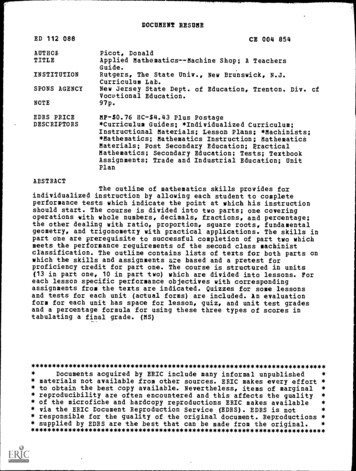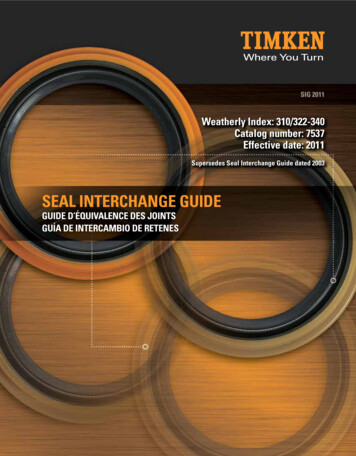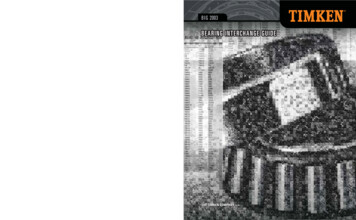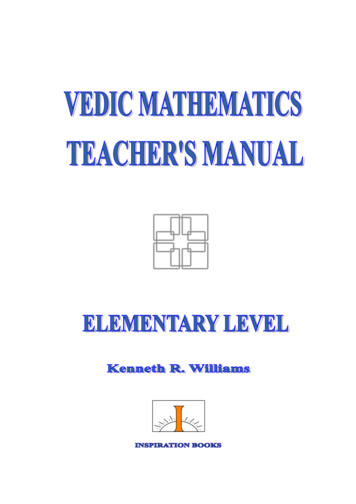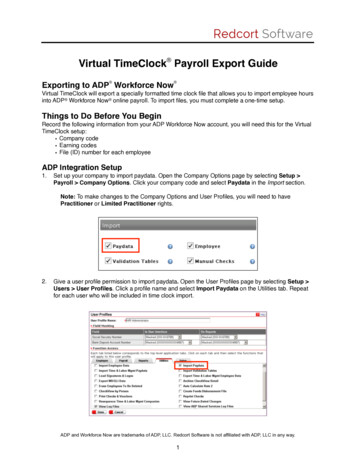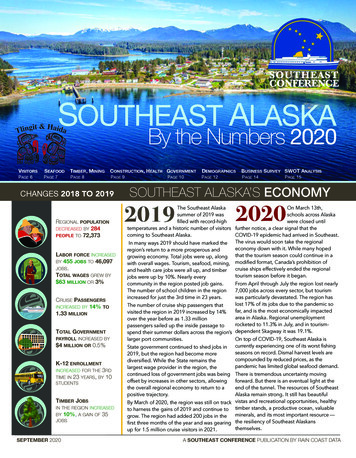
Transcription
SOUTHEASTCONFERENCESOUTHEASTCONFERENCESOUTHEAST ALASKABy the Numbers 2020VISITORSSEAFOODTIMBER, MININGCONSTRUCTION, HEALTH GOVERNMENTDEMOGRAPHICSBUSINESS SURVEY SWOT ANALYSISPAGE 6PAGE 7PAGE 8PAGE 9PAGE 12PAGE 14CHANGES 2018 TO 2019REGIONAL POPULATIONDECREASED BY 284PEOPLE TO 72,373LABOR FORCE INCREASEDBY 455 JOBS TO 46,097JOBS.TOTAL WAGES GREW BY 63 MILLION OR 3%CRUISE PASSENGERSINCREASED BY 14% TO1.33 MILLIONTOTAL GOVERNMENTPAYROLL INCREASED BY 4 MILLION OR 0.5%K-12 ENROLLMENTINCREASED FOR THE 3RDTIME IN 23 YEARS, BY 10STUDENTSTIMBER JOBSIN THE REGION INCREASEDBY 10%, A GAIN OF 35JOBSPAGE 10PAGE 15SOUTHEAST ALASKA’S ECONOMYThe Southeast AlaskaOn March 13th,summer of 2019 wasschools across Alaskafilled with record-highwere closed untiltemperatures and a historic number of visitors further notice, a clear signal that thecoming to Southeast Alaska.COVID-19 epidemic had arrived in Southeast.The virus would soon take the regionalIn many ways 2019 should have marked theeconomy down with it. While many hopedregion’s return to a more prosperous andgrowing economy. Total jobs were up, along that the tourism season could continue in awith overall wages. Tourism, seafood, mining, modified format, Canada’s prohibition ofcruise ships effectively ended the regionaland health care jobs were all up, and timbertourism season before it began.jobs were up by 10%. Nearly everycommunity in the region posted job gains.The number of school children in the regionincreased for just the 3rd time in 23 years.From April through July the region lost nearly7,000 jobs across every sector, but tourismwas particularly devastated. The region haslost 17% of its jobs due to the pandemic soThe number of cruise ship passengers thatfar, and is the most economically impactedvisited the region in 2019 increased by 14%area in Alaska. Regional unemploymentover the year before as 1.33 millionrocketed to 11.3% in July, and in tourismpassengers sailed up the inside passage tospend their summer dollars across the region’s dependent Skagway it was 19.1%.larger port communities.On top of COVID-19, Southeast Alaska iscurrently experiencing one of its worst fishingState government continued to shed jobs inseasons on record. Dismal harvest levels are2019, but the region had become morecompounded by reduced prices, as thediversified. While the State remains thepandemic has limited global seafood demand.largest wage provider in the region, thecontinued loss of government jobs was beingoffset by increases in other sectors, allowingthe overall regional economy to return to apositive trajectory.There is tremendous uncertainty movingforward. But there is an eventual light at theend of the tunnel. The resources of SoutheastAlaska remain strong. It still has beautifulBy March of 2020, the region was still on track vistas and recreational opportunities, healthyto harness the gains of 2019 and continue to timber stands, a productive ocean, valuableminerals, and its most important resource —grow. The region had added 200 jobs in thefirst three months of the year and was gearing the resiliency of Southeast Alaskansthemselves.up for 1.5 million cruise visitors in 2021.SEPTEMBER 2020A SOUTHEAST CONFERENCE PUBLICATION BY RAIN COAST DATARaincoast DataTimber, Food Security, Energy Draft 1
A Message from Southeast ConferenceExecutive DirectorRobert VenablesResiliency in Southeast. This is not a onetime theme or “event”. This will be ourundertaking during what is likely to be a“2-year winter economy”. Thispandemic-induced economic coma andits aftermath could last a long time.First, a word of thanks to our publicofficials at every level for taking the stepsdeemed best to ensure the physicalhealth of every citizen. And to the best of their ability, they areproviding resources to stabilize the business sector to getthrough the initial stages of this pandemic.Southeast Conference is focused on a two-year resiliency effortthat can assist communities and businesses develop and executea successful economic recovery plan. The economic toll of thepandemic has been especially harsh on small and medium-sizedbusinesses. They lack the capital to continue operations orrestart their businesses after a prolonged shutdown. Our surveyshowed a high level of uncertainty under a fear of bankruptcy.The Southeast Conference 2025 regional comprehensiveeconomic development strategy will help guide efforts andinvestments in priority objectives that can help businesses reviveand create jobs. Together we will identify potential resiliency,mitigation, and economic recovery action items that will lead toeconomic revitalization in Southeast Alaska.Where can infrastructure investment stimulate the economy andprepare the region for a more resilient future? Can technologyand automation be the tools of future economies? Join us as wework with local, state, tribal and federally led coronavirusrecovery planning efforts and identify economic developmentprojects and take full advantage of available fundingopportunities.Working together, we can speed the recovery process throughstrategic planning and foster private and non-profit partnershipopportunities. Failure is not an option. Unfortunately, the regionhas vast experience in reinventing its economy after suddenshutdowns in our natural resource and extraction industries. Andeach time, we rose to the occasion and worked together towardthe Southeast Conference mission of strong economies, healthycommunities, and a quality environment in Southeast Alaska.Incoming PresidentMarkos ScheerSoutheast Alaska is such a unique place. It isa place of unparalleled beauty, withthousands of miles of coastline, lakes,island, bay, nooks and crannies that fewhave explored, and all is bordered bysnowcapped mountains, like parapets,protecting the 800 miles region that extendsfrom the southern border south of Ketchikanto Yakutat. The ingenuity, toughness andresiliency of its people and communities is second to none.Southeast Conference reflects those people and the environment inwhich these special Alaskans live, work and play. It is diverse,expansive, spans hundreds of miles and folks are busy with the diverseindustries that make Southeast run, including our fishing, mining,mariculture, timber, tourism, and maritime industries. For more than 60years Southeast Conference is one of the ways that all of Southeast, itspeople, towns, villages and business come together to work on how tomake this remarkable area more prosperous. It is a greatrepresentation of how people, communities and businesses, eventhose that are separated by hundreds of miles, all work together forcollective economic growth – a rising tide does indeed raise all ships.In these challenging times, the value of the role of SoutheastConference can play, as a facilitator, connector and proponent forSoutheast businesses, communities and people cannot be overstated.There are many challenges, including COVID-19 and its effects on allof us, the metamorphosis of the fishing, tourism, charter, timber andmining industries in Southeast Alaska and the ongoing work to bring aviable and reliable ferry system back online. Southeast Conference isuniquely positioned to help the region respond to these manychallenges and create economic opportunities for everyone.I moved to Southeast Alaska in 1982. I lived in Thorne Bay, Hollis,Klawock and then Ketchikan. I graduated from Ketchikan High Schoolin 1986. I attended Sitka Fine Arts Camp. I worked for Silver Lining,then a startup Southeast Alaska based seafood company for 12 years.For the next 20 years, I practiced law in Alaska and the west coast,working with seafood and maritime companies that plied the watersfrom the Bering Sea to California. I became involved in SoutheastConference to lend what I could to the collective efforts. Now that Irun a burgeoning mariculture business in Southeast Alaska, the truevalue of Southeast Conference – and the communities and people thatsupport it -- is even more clear. I look forward to the honor andopportunity to serve as the President of Southeast Conference overthe next year.The mission of Southeast Conference is to undertake and support activities that promote strong economies, healthy communities and aquality environment in Southeast Alaska. As the state and federally-designated regional economic development organization, SoutheastConference serves as the collective voice for advancing the region’s economy. We have 200 member organizations representing 1,200 peoplefrom 32 regional communities. We started 60 years ago with a group of people supporting the establishment of a regional transportationsystem, leading to the formation of the Alaska Marine Highway System. Our members stayed together through more than a half-century tofocus on concerns unique to the region.Image Credits: Front cover photo of Angoon by Heather Holt. Icons by Avery Veliz.Southeast Alaska by the Numbers 2020Prepared by Rain Coast DataPage 2
SEQUOIACLCHANGE IN THE LAST YEAR: 2018 to 2019DEMOGRAPHICSPopulation 1Ages 65 and older 2Under Age Five 2Twenty somethings 2K-12 School District Enrollment 3GENERAL ECONOMIC CONDITIONSTotal Labor Force (jobs, includes self-employed & USCG)1,5,6Total Job Earnings1, 5, 6Total Private Sector Payroll 1, 6Average Annual Wage 1Annual Unemployment Rate 1TOP ECONOMIC SECTORSGOVERNMENTTotal Government Employment 1, 5Federal Employment 1, 5 (8% of all employment earnings)State Employment 1 (14% of all job earnings)City and Tribal Employment 1 (14% of all job earnings)Total Government Payroll (includes USCG) 1, 5Total State of Alaska PayrollVISITOR INDUSTRYTotal Visitor Industry Employment 1, 6Total Visitor Industry Wages/Earnings 1, 6Total Southeast Alaska Passenger ArrivalsCruise Passengers 10Total Air Passenger Arrivals from Outside SE 11Total AMHS Passengers from Outside SE 12COMMERCIAL FISHING & SEAFOOD INDUSTRYTotal Seafood Employment (includes fishermen) 1, 6Total Seafood Employment Earnings 1, 6Value of Seafood Processed 7Pounds Landed (commercial seafood whole pounds by SE residents) 8Estimated Gross Earnings (ex-vessel value of pounds landed) 8HEALTH CARE INDUSTRY (PUBLIC & PRIVATE HEALTH)Health Care Employment 1, 6Health Care Wages 1, 6MARITIME ECONOMY (Includes employment from all industries)Private Maritime plus USCG Employment 1,5,6Private Maritime plus USCG Wages 1,5,6OTHER SELECTED STATISTICSConstruction Employment 1, 6 (6% all employment earnings)Mining Employment 1 (4% of all employment earnings)Timber Employment 1 (4% of all employment earnings)Price of Gold 7Total Southeast AMHS Ridership12Cost of Living: Consumer Price Index1Housing Starts: Housing Permitted /Completed 4,1Avg. Daily Volume ANS Oil Production (mbbls/day)14Annual Avg. Domestic Crude WTI Oil Prices (in /Barrel)14UBTable tracks key Southeast indicators over thepast year, along with associated 11,5443,9568,31911,34445,642 2.28 billion 1.51 billion 50,0235.9%201846,097 2.35 billion 1.56 billion 50,8735.9%2019% 9-284489-181-104101%3%4%2%0.0%455 62.9 million 59.1 million8500.0%% CHANGECHANGEPUBLIC SECTOR: 33% OF ALL EMPLOYMENT EARNINGS13,1482,1114,7716,266 776.9 million 283.3 million12,9942,0324,7056,257 780.7 million 284 million-1%-4%-1%-0.1%0.5%0.2%-154-79-66-9 3.77 million 702,0328,004 249.3 million1,618,3111,169,000435,47613,8358,394 271.6 -17%390 22.3 million169,034162,6008,741-2,3073,711 237.4 million439.7 million185.2 million 246.9 million3,743 238.0 million422.0 million208.3 million 217.6 million1%0%-4%13%-12%32 584,614-17.6 million23.2 million- 29.3 million3,547 216.8 million3,574 227.4 million0.8%5%27 10.6 million6,273 396.8 million20186,544 408.9 million20194%3%271 12.1 million1,909889337 1,269179,312225.5188508,601 71.711,903934372 1,392135,388228.7294489,771 65.49KEY INDUSTRY: 11% OF ALL EMPLOYMENT EARNINGSKEY INDUSTRY: 10% OF ALL EMPLOYMENT EARNINGSKEY INDUSTRY: 11% OF ALL EMPLOYMENT EARNINGSTOP SECTOR: 27% OF PRIVATE SECTOR EMPLOYMENT EARNINGS% 9243106-18,830- 6.22Sources: 1Alaska Department of Labor (ADOL); 2ADOL Southeast Alaska Population by Age, 2018, 2019; 3Alaska Department of Education and Early Development; 4Based on thequarterly Alaska Housing Unit Survey, a survey of local governments and housing agencies; 5 US Coast Guard; 6 2018 US Census Nonemployer (self-employment) Statistics; 7KitcoMetals Inc.; 8ADF&G Southeast Alaska Commercial Seafood Industry Harvest and Ex-Vessel Value Information, 2018, 2019; 10Cruise Line Agencies of Alaska; 11US Bureau ofTransportation Statistics (RITA); 12Alaska Marine Highway System data; 14Alaska Department of Revenue Crude Oil and Natural Gas Prices.Nullam arcu leo, facilisis ut3
25O-50%ASTCONFERENC-2,025-38%Leisure & Hospitality-2,000-27% Seafood Processing17%It is too early to measure the full impacts ofCOVID-19 on Southeast Alaska jobs and theof SE jobs economy. However, early job numbers providevaluable insights. Between April and July 2020,lostSoutheast Alaska was down nearly 7,000 jobs, or17% of its total workforce, compared to the sameperiod in 2019. Jobs in Southeast have been lost at a much higher ratethan the rest of Alaska, with other regions being down between 6% and14% of their workforce. Hardest hit were those sectors that providetourism services. Combined the transportation, leisure, and hospitalitysectors shed 4,025 jobs, with the transportation sector being down by50% due to the decline of scenic and sightseeing transportationactivities. For purposes of this analysis, April through July employmentlosses were averaged over that period. A July-only snapshot for tourismrelated sectors shows a decline of 5,400 regional jobs over July 2019.-425-17% Professional Svcs-300-15% Information-75-11% Retail-525-8% StateMunicipal Gov’t -8%-400-400Tribal Gov’t -7%-75Construction -5%-75The seafood processing sector was down by 27% (425 jobs) betweenApril and July compared to 2019. These jobs losses were exacerbatedby the abysmal summer salmon returns and compounded by lowseafood prices. The struggling state sector, which had already been cutdeeply in prior years, was down by 400 additional jobs (8%) betweenApril and July, compared to the same period in 2019. On a positivenote, the mining and logging sectors experienced no changes inworkforce levels during COVID-19 so far.Financial Activities -5%-50Note that self-employment data for this period is not available and hasnot been included in this analysis. Approximately one-fifth of Southeastjobs are independent workers, including sole-proprietors and commercialfishermen.April to July 2020Compared to Aprilto July 2019By Region-0.375-0.25Health Care -4%EMining and Logging0 0%Loss of Alaska Jobs:-0.125Between July of 2019 and July of 2020, the Southeast Alaska unemployment ratejumped from 4.7% to 11.3%. The Skagway Borough currently has the second highestunemployment rate in Alaska as a whole, with an unemployment rate of 19.1%.Southeast Alaska’s unemployment rate was higher than that of the state or nation forJuly. In April 2020, theSoutheast unemployment rate reached19.1% regional unemployment rate.13.9%. Sitka has the lowest15.9%0Northern-12%Interior-11%Anch/ -11%Mat-SuSouthwest-6%How do COVIDSoutheast joblosses compare?Gulf e ofWalesHyder 4.5%-100Federal Gov’t -2% -25Southeast Alaska July Unemployment 2020Southeast0ETransportationAlaska5HChange in Southeast Jobs: April Seafoodto JulyProcessing2020 Compared to 2019 -6,850UnitedStates0T2020 Southeast Jobs COVID Impacts11UCOVID-19 Impacts 20202SSource: Alaska Department of LaborSoutheast Alaska by the Numbers 2020Prepared by Rain Coast DataPage 4
SOUTHEASTCONFERENCEThe Whole Southeast Alaska Economy 2019In 2019, Southeast Alaska gained 455 year-round equivalent jobs and 63 million in workforce earnings over 2018. Approximately aquarter (26.1%) of regional workers are non-residents.Annual Average JobsEmployment EarningsUP 455 JOBSUP 63 MILLION 3%46,097 Jobs2019 1%Visitor Industry18%Private Health Care8%s,ieilitUtg,%sinou%%g2InTr fo,an Tisp mbor er,WtSocia 5% arehltiliUg,3%sinouesrvicSeMininOther4%ing4InTr fo,an Tisp mbor ert,WSocia 4% arelhFed Gov't8%Min%s4itietivAcialanc6%Final ServicesProfessionConstruction 4%ties,Private Health na ional SFifessProConstruction 6%Fed Gov't4%VisitorIndustry12%State Gov't12%Seafood8%State Gov't10%Other6%Local Gov't13%ices2Local Gov't14%ServIN 2.3 Billion Workforce EarningsTrade6%2019 Southeast Alaska Employment EarningsEMPLOYMENT RELATED EARNINGSEMPLOYMENT NUMBERSAnnual AverageEmployment(2019)SelfEmployed(2018)Wages (2019)Self-EmploymentEarnings (2018)Total EarningsGovernment (includes Coast Guard) 720,119,719 60,582,082* 780,701,80212,354640*12,994Visitor Industry 235,179,580 36,429,000 271,608,5807,3441,0508,394Seafood IndustryTotalEmployment 69,711,072 168,316,000 238,027,0721,4972,2463,743Trade: Retail and Wholesale 123,764,467 24,031,000 147,795,4673,9055674,472Health Care Industry (private only) 171,156,119 14,417,000 185,573,1192,7622633,025Construction Industry 92,347,611 38,999,000 131,346,6111,3325711,903Financial Activities 54,349,824 74,373,000 128,722,8241,0727611,833Professional and Business Services 78,474,062 43,487,000 121,961,0621,6221,3192,941Mining Industry 94,460,451 307,000 94,767,4519277934Social ServicesInformation (publishing, broadcasting, telecomm.) 40,307,321 3,977,000 44,284,321 22,941,315 1,358,000 24,299,3151,227475187601,414535Timber Industry 20,478,427 2,038,000 22,516,42731557372Warehousing, Utilities, & Non-Visitor Transport 53,270,575 14,500,000 67,770,575815162977Other 60,615,872 25,120,000 85,735,8721,6579032,560Total 1,837,176,415 507,934,083 2,345,110,49837,3048,79346,097Sources: Alaska Department of Labor 2019 Employment & Wage data; 2018 (latest available) US Census Nonemployer (self-employment) Statistics; Active Duty Military Population by2019, ADOL.*These cells in Government refer to 2019 active duty Coast Guard personnel employment and wages, and not self-employment data.Notes: Seafood Industry includes animal aquaculture, fishing & seafood product preparation, and Southeast Alaska resident commercial fishermen (nonresident fishermen & crew whodid not report income are excluded). Visitor Industry includes leisure & hospitality, and visitor transportation (air, water, scenic). Timber includes forestry and logging support activitiesfor forestry, and wood product manufacturing.Southeast Alaska by the Numbers 2020Prepared by Rain Coast DataPage 5
r Industry8,350 Annualized Jobs 272 Million in WagesU P 3 90 J O B S I N 2 0 1 9 5 %WAGES UP 9%The 2019 visitorseason in SoutheastAlaska was recordbreaking by nearly every measure: passengerarrivals increased by 10%, industry wages by9%, and jobs grew by 5%. In 2019 the visitorindustry was the largest jobs provider for theregion, accounting for 18% of all annualizedemployment in Southeast Alaska. The visitorsector paid out more wages than any otherprivate sector industry and had been set tosurpass the state and municipal sectors tobecome the largest wage provider in theregion overall in 2020.The gains in 2019 followed a meteoric rise.Since 2011, tourism added 2,400 year-roundequivalent jobs to the Southeast economy,growing to 8,350 annualized jobs, whiletourism workforce earnings grew by 66%.Those working in the visitor industry earned 272 million in 2019—or 12 percent of allregional employment income. The averageannualized wage in the visitor industry was 32,360, lower than the average regionalwage of 50,870, but that figure had alsobeen steadily increasing over time.In 2019, 1.8 mil
PAYROLL INCREASED BY 4 MILLION OR 0.5% K-12 ENROLLMENT INCREASED FOR THE 3RD TIME IN 23 YEARS, BY 10 STUDENTS TIMBER JOBS IN THE REGION INCREASED BY 10%, A GAIN OF 35 JOBS SOUTHEAST ALASKA’S ECONOMY The Southeast Alaska summer of 2019 was filled with record-high temperatures and a historic number of visitors coming to Southeast Alaska.
